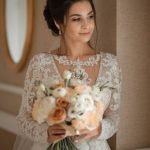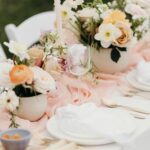Choosing the right colors to wear to a wedding is crucial for any guest, as it reflects respect for the couple and their special day. The significance of color choices varies across different cultures and traditions, making it important to be mindful of the symbolism behind certain colors.
Understanding color theory and how it applies to wedding attire can help in making informed decisions when selecting the perfect outfit for the occasion. Whether it’s a traditional or modern ceremony, the right color choice can enhance your overall look and ensure you are appropriately dressed for the event.
In different cultures and traditions, certain colors hold significant symbolism that may influence wedding attire choices. Whether it’s a matter of luck, purity, or prosperity, this aspect plays an essential role in determining what colors are deemed appropriate for such a celebration. It’s important to appreciate these cultural nuances as we navigate through the process of selecting suitable options.
Understanding how color theory works can be instrumental in helping guests choose the most flattering hues for their wedding attire. Consideration of shade variations, undertones, and even complementary shades can make a significant difference in achieving an elegant and put-together look.
As we delve into this article, we will explore not just traditional color choices but also provide insight into how seasonal considerations and dress code etiquette factor into making the right decision on what colors to wear to a wedding.
Understanding Color Theory
When it comes to choosing the right colors to wear to a wedding, understanding color theory is essential. Color theory is the study of hues and how they can be combined in different ways to create visually pleasing combinations. Knowing the basics of color theory can help you make informed decisions about your wedding attire, ensuring that you look and feel your best on the big day.
Basics of Color Theory
Color theory revolves around the color wheel, which is made up of primary, secondary, and tertiary colors. These colors can be mixed, matched, and combined to create various palettes that evoke different emotions and vibes. For example, complementary colors are those that are directly opposite each other on the color wheel and create a striking contrast when paired together. Understanding these basic principles can help you choose colors that work well together for your wedding outfit.
Choosing Colors for Your Skin Tone
In addition to understanding the fundamentals of color theory, it’s important to consider how different shades and undertones of colors can complement your skin tone. For example, individuals with warm undertones may find that earthy tones such as terracotta or mustard complement their complexion, while those with cool undertones may opt for jewel tones like emerald or sapphire.
When deciding what colors to wear to a wedding, take into account not only your personal preferences but also what will flatter your natural features.
Traditional Wedding Colors
When attending a wedding, it is essential to consider the traditional wedding colors and their significance in various cultures and regions. In Western cultures, white is the traditional color for weddings, symbolizing purity and new beginnings.
However, in some Eastern cultures, such as China and India, red is the customary wedding color, representing luck, happiness, and prosperity. Understanding these traditional color choices can help guests navigate what colors to wear to a wedding while respecting the cultural significance behind these choices.
In addition to white and red, other traditional wedding colors include gold, which symbolizes wealth and prosperity in many cultures. Blue is also a popular choice in weddings around the world due to its association with tranquility and loyalty. It’s important to consider these traditional meanings when choosing attire for a wedding celebration.
| Traditional Wedding Colors | Significance |
|---|---|
| White | Purity and new beginnings |
| Red | Luck, happiness, and prosperity |
| Gold | Wealth and prosperity |
Understanding these traditional color choices will not only help you select appropriate attire but also ensure that you are honoring the cultural significance of the event. By being mindful of these traditions, guests can show respect for different customs while celebrating love and unity at wedding ceremonies around the world.
Seasonal Considerations
When it comes to choosing what colors to wear to a wedding, considering the season and time of day is crucial. Different seasonal palettes can have a significant impact on the overall look and feel of wedding attire. For example, light pastel shades are popular for spring weddings, while rich, deep tones are often preferred for fall and winter ceremonies. Understanding how seasonal color palettes work can help you make the right choice for your wedding outfit.
Spring weddings are often associated with soft and delicate colors such as pastel pinks, blues, and yellows. These colors evoke a sense of renewal and new beginnings, reflecting the spirit of the season. Light and airy fabrics like chiffon or organza in these hues are perfect for a springtime affair.
On the other hand, fall weddings are an opportunity to explore deeper shades like burgundy, navy, or emerald green. These rich tones complement the cozy atmosphere of autumn weddings and create a warm and inviting vibe.
For summer weddings, bright and vibrant colors like coral, turquoise, or lavender can be stunning choices. These hues add a cheerful and festive touch to summer celebrations. When it comes to winter weddings, consider colors like deep reds, forest greens, or royal blues to capture the coziness and elegance of the season.
Understanding seasonal color palettes is not only helpful for choosing your own outfit but can also guide you when selecting attire for bridal party members or guests at a wedding. By following seasonal color suggestions, you can ensure that your wedding ensemble will be both stylish and appropriate for the time of year.
| Season | Suggested Colors |
|---|---|
| Spring | Pastel pinks, blues, yellows |
| Fall | Burgundy, navy, emerald green |
| Summer | Coral, turquoise, lavender |
| Winter | Deep reds, forest greens, royal blues |
Dress Code Etiquette
When attending a wedding, it’s important to adhere to the dress code specified by the couple. Different dress codes require different color choices, so it’s essential to understand the etiquette for each one.
- Black-Tie: For black-tie weddings, guests are expected to wear formal and elegant attire. Men should opt for a tuxedo or a dark suit, while women can choose from long evening gowns or chic cocktail dresses. Classic colors such as black, navy, deep red, or emerald green are perfect for black-tie events.
- Formal: Formal weddings also call for sophisticated and polished looks. Men can opt for a dark suit and tie, while women can choose elegant floor-length gowns or formal cocktail dresses. Colors like navy, burgundy, forest green, and deep purple are appropriate for formal affairs.
- Semi-Formal: Semi-formal weddings allow for a slightly more relaxed dress code. Men can wear a suit and tie in light colors or even opt for dress pants paired with a blazer. Women have the option of wearing chic cocktail dresses in pastel shades such as blush pink, baby blue, lavender, or mint green.
- Casual: Casual weddings provide more flexibility in terms of attire. For men, slacks paired with a button-down shirt and loafers would suffice. Women can opt for sundresses or skirts paired with blouses in cheerful colors such as coral, sky blue, lilac, or peach.
Understanding the appropriate colors to wear to a wedding based on the dress code not only shows respect for the couple but also ensures that guests are dressed appropriately for the occasion.
It’s important to remember that when choosing your outfit’s color palette for a wedding of any kind – whether it be classic black-tie event or laid-back beach affair – take cues from the season as well as whether it is an outdoor ceremony under sunlight or an indoor evening celebration alike.
Colors to Avoid
When it comes to choosing the perfect outfit for a wedding, it’s just as important to know what colors to avoid as it is to know what colors to wear. Certain colors are considered inappropriate or taboo for wedding attire in different cultures and traditions. Understanding these color restrictions can help ensure that you don’t unintentionally offend the couple or their families on their special day.
Cultural Taboos
In many cultures, certain colors are associated with mourning or bad luck, and wearing them to a joyous occasion like a wedding would be highly inappropriate. For example, in Chinese culture, black and white are traditionally worn at funerals, making them unsuitable for weddings. Similarly, in Hindu culture, it is customary to avoid wearing black or dark colors to weddings as they are associated with mourning.
Symbolism and Superstitions
Certain colors may also carry negative connotations or superstitions in different regions. For example, in some Latin American countries, yellow is associated with death and would be considered inappropriate for wedding attire. In Middle Eastern cultures, green can be seen as a symbol of bad luck and should be avoided at weddings.
Avoiding Clashes With the Wedding Party
It’s also important to consider the color scheme of the wedding itself when choosing your outfit. If the couple has chosen specific colors for their decorations or wedding party attire, it’s best to avoid wearing those same colors so as not to clash or blur into the background of photographs.
Understanding these cultural taboos and superstitions around color choices can help ensure that you show respect for the couple and their families on their special day. By avoiding these inappropriate colors, you can demonstrate consideration for traditional beliefs while still looking stylish and elegant at the wedding.
Matching Colors With Accessories
When it comes to accessorizing wedding attire, it’s important to choose colors that complement your outfit and enhance your overall look. Whether you’re the bride, groom, part of the wedding party, or a guest, picking the right accessories can make a significant impact on your ensemble. Here are some tips for matching colors with accessories:
Accessories should enhance and not overpower your outfit. If you’re wearing a bold or colorful dress or suit, opt for more subtle and neutral accessories to balance out the look. For example, if you’re wearing a vibrant floral dress to a spring wedding, consider pairing it with nude heels and a simple clutch.
Consider the undertones of your outfit when choosing accessory colors. If your attire has warm undertones, such as ivory or cream, opt for gold or earthy-toned accessories. For cooler undertones like pure white or silver, consider pairing with silver or jewel-toned accessories.
Keep in mind the season and time of day of the wedding when choosing accessory colors. For a summer daytime wedding, light and airy pastel-colored accessories can be perfect. In contrast, for an evening winter wedding, deep jewel-toned accessories add a touch of elegance.
Remember that less is often more when it comes to accessorizing for weddings. Avoid overdoing it with too many statement pieces – choose one or two key accessories to highlight your look without overshadowing it.
By following these guidelines for matching colors with accessories, you’ll be able to create a cohesive and polished wedding ensemble that complements both your personal style and the overall aesthetic of the event.
Personal Style and Individuality
In conclusion, the question of what colors to wear to a wedding is an important consideration that goes beyond personal preference. Understanding color theory, traditional wedding colors, seasonal considerations, dress code etiquette, and cultural taboos can all influence the decision-making process. It’s important to consider these factors while also expressing one’s personal style and individuality.
Ultimately, when choosing the perfect color for wedding attire, it’s essential to strike a balance between tradition and personal expression. Whether it’s incorporating a pop of color through accessories or selecting a classic hue that complements the season, there are various ways to make a stylish statement while still respecting the significance of the event.
By understanding the cultural and traditional symbolism behind certain colors and embracing them in a way that reflects personal style, one can navigate the often-ambiguous world of wedding dress codes with confidence.
While there may be specific guidelines and etiquette to follow when it comes to dressing for a wedding, it’s also important not to lose sight of individuality. The key is to find harmony between adhering to social expectations and expressing oneself authentically. Remember, weddings are joyous occasions that celebrate love and unity, so whatever color you choose to wear should ultimately reflect your own happiness and well-wishes for the couple on their special day.
Frequently Asked Questions
What Is the Best Color to Wear to a Wedding?
The best color to wear to a wedding is typically something that isn’t white (out of respect for the bride) or anything too attention-grabbing. Soft, pastel colors and florals are often safe choices.
What Should I Wear to a Wedding as a Guest?
As a wedding guest, it’s important to dress appropriately for the occasion. For men, this usually means wearing a suit or dress pants with a dress shirt and tie. For women, a cocktail dress or formal jumpsuit can be a good choice.
Can You Wear Black to a Wedding?
Traditionally, wearing black to a wedding has been seen as taboo since it’s often associated with mourning or funerals. However, in modern times, black is becoming more acceptable as long as the overall look is not too somber and paired with colorful accessories.

Welcome to my blog about home and family. This blog is a place where I will share my thoughts, ideas, and experiences related to these important topics. I am a stay-at-home mom with two young children. I hope you enjoy reading it! and may find some helpful tips and ideas that will make your home and family life even better!





